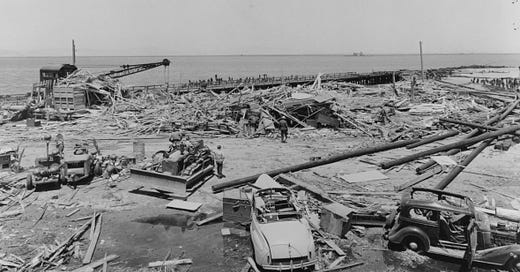Covering the Port Chicago disaster
Most of the first six pages of the Oakland Tribune's July 18, 1944 edition -- two of them composed entirely of pictures -- were dedicated to covering a single incident that was over within seconds.
"300 DIE IN BAY ARMS SHIP BLAST" the headline above Johnny Noble's Page 1 story blared. His piece and the words and pictures on the pages that followed chronicled in great detail the devastating munitions explosions that killed all 320 men on duty at the Port Chicago Naval Magazine and injured 390 more people in the surrounding area.
The two ships involved were the SS Quinault Victory, which was being loaded for its first voyage, and the other the SS E.A. Bryan, which had just completed its maiden voyage. Noble's story estimated more than 10,000 tons of explosives had gone off in a pair of blasts, but the Navy's later official tally was about half that, including the munitions on the ships and rail cars nearby.
Wrote Noble:
Residents of Martinez, five miles from the dock, were awakened at 10:19 p.m. by a great sheet of white fire that flashed across the sky. An instant later, the first of the two explosions knocked them down from their beds.
All spectators were dazed by the terror of the explosions, but all agreed that there were two blasts. ... Observers this morning found pieces of jagged metal more than a mile from the scene, and one farmer reported that he had picked up a five-inch shell two miles away. ...
The scene of carnage along the wharf was so bad today that Navy officers were reluctant to permit civilian photographers on the scene.
Noble's story went on to describe the chaos that descended on the small town of Port Chicago, with emergency vehicles and medical and military personnel streaming toward the blast site from all over the Bay Area.
The Tribune's inside pages were dotted with short items detailing the effects of the twin blasts. On Page 4, a five-paragraph story told the story of "Floyd Scott, 19, Negro, U.S. Navy painter 3/c," who had been reading a comic book in the barracks at the time of the explosion. Believing he wouldn't escape alive, Scott clutched in his fist the address of a friend in Oakland who would be able to identify his body.
The paper on which the address was written was still clenched in his first -- a sodden mess -- when he was brought into a Martinez hospital for treatment of shocked nerves. Scott escaped serious injury, although his clothing was torn from his knees and chest as if by a gigantic hand.
The Scott sidebar was one of only a couple of mentions of Black victims in the Tribune. As more information became available in the coming days, though, the extent to which Black enlisted men bore the brunt of the disaster became clear.
The country's major Black newspapers sent staff writers to the scene, including J. Robert Smith of the Chicago Defender. His front-page story in the July 29 edition of the weekly paper led this way:
The United States Navy did not have to sound taps or perform last rites this week for the 250 Negro seamen who died in line of duty in the explosion here last Monday night, for not a single body of the sailors who were loading the SS Quinault Victory and the SS E.A. Bryan has been recovered, either on land or sea.
The Navy's official history now says the 320 dead that night included 202 Black enlisted men -- accounting for 15 percent of all African American casualties in World War II.




